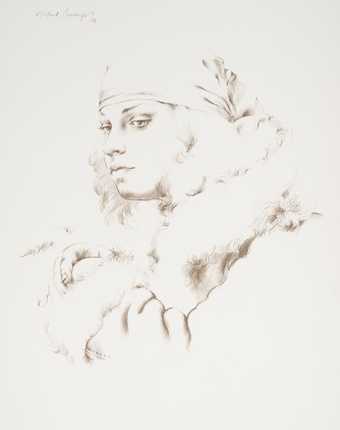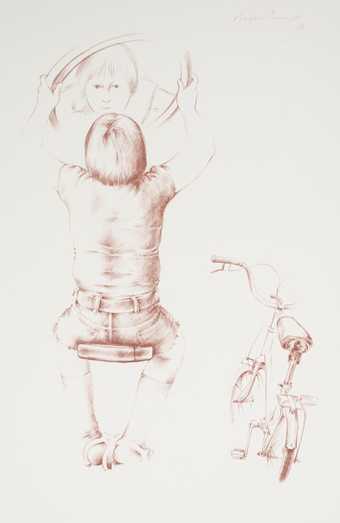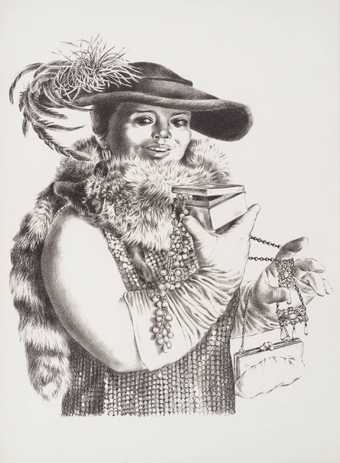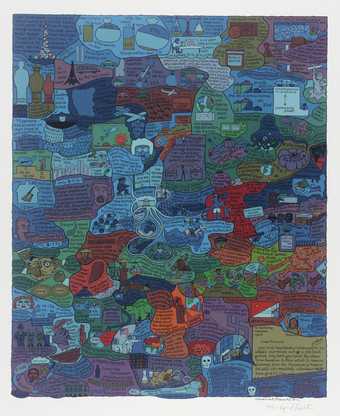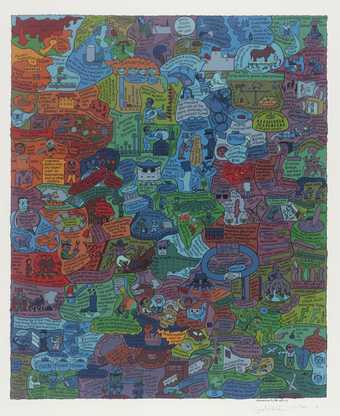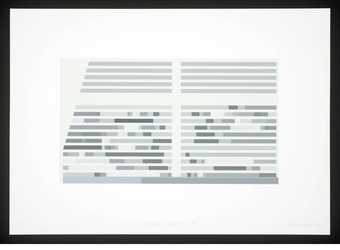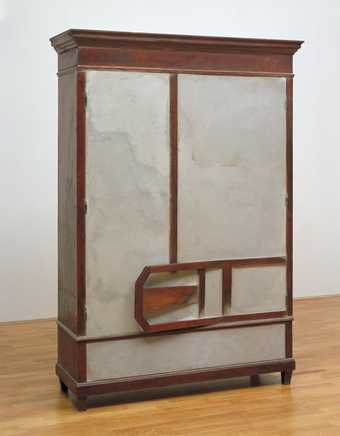
Not on display
- Artist
- Antonio Caro born 1950
- Medium
- Screenprint on paper
- Dimensions
- Support: 497 × 708 mm
- Collection
- Tate
- Acquisition
- Presented by Becky Mayer 2011
- Reference
- P13173
Summary
In the screenprint Colombia 1977, Antonio Caro has reproduced the Colombian national flag and added the name of the country – using the calligraphy of the ubiquitous Coca-Cola logo – to the lower red stripe. With this graphic play, Caro contrasts the assertion of national identity with the intrusion of a foreign commercial emblem. In 1976, Caro had initiated a series of works around the theme of Colombia and Coca-Cola. He started making drawings writing the word Colombia as if it were the logo of the famous drink. He then transferred the design of his drawings into a painting on brass, writing in white enamel over a bright red enamel background, mimicking the packaging and advertisements of the global consumer product. This work received a special mention in the Salón Nacional de Artistas in Bogotá in 1976.
In an earlier work, Caro had already combined a packet of Marlboro cigarettes with a small cart made of wire. Through the apparently innocent vehicle of a children’s toy, Caro produced a commentary on the irruption of international brands, and specifically North American consumer products, into the local customs of Colombia. Later, once Caro’s Colombia image obtained wide recognition through exhibition, he exploited its graphic qualities and potential for reproduction and dissemination by transferring it into prints, including this screenprint.
The use of text is a predominant feature of Caro’s work, whether in the form of drawings or prints. He explores the expressive potential of concise, powerful messages, mimicking political slogans, which are easily disseminated. His graphic work has been characterised as a politically-charged form of pop art. As critic Carmen Jaramillo has observed:
Caro tries to merge meanings, create ambiguity and, finally, generate a new semantic reality. The reference to the economic and cultural colonization of Colombia by the United States, more than helping to define the idea of nation or identity, critically contributes to increase the doubts and the questions about it.
(ASAB 2002, p.64.)
Writing more recently, the critic Diego Guerrero pointed out in the Colombian newspaper El Tiempo:
With the passing of time, and after being reproduced in book covers, magazines and even little flags, Colombia Coca-Cola has become an icon, and remains so young that it could have been made yesterday. With Colombia Caro did not make a painting: he created a concept.
(Diego Guerrero, ‘Colombia, una obra muy Coca Cola’, El Tiempo, 20 July 2008.)
Caro’s work represents an irreverent and critical look at the social and political conditions of his country, in particular at the way in which certain historical processes have been assimilated by mainstream and popular culture. To this end, he has resorted to media more commonly associated with mass communication strategies than with traditional forms of art practice: posters and public lectures, as well as prints and installations. He has also employed materials and techniques associated with indigenous cultures, such as salt and the spice achiote. In 1999 his work was included in the exhibition Global Conceptualism: Points of Origin, 1950s–1980s at the Queens Museum of Art, New York. The exhibition’s co-curator, artist Luis Camnitzer, described Caro as fitting ‘within the artistic trend that since the 1960s is known as conceptualism. But he also fits within something broader and more important culturally. Caro is in a very particular way a visual guerrilla’ (Camnitzer 1995, p.44).
Further reading
Luis Camnitzer, ‘Antonio Caro: Guerrillero Visual, Visual Guerrilla’, Polyester, vol.4, no.12, Summer 1995, p.43.
Luis Camnitzer, Jane Farver and Rachel Weiss (eds.), Global Conceptualism: Points of Origin, 1950s–1980s, exhibition catalogue, Queens Museum of Art, New York 1999.
Carmen María Jaramillo, Colombia: Años 70, Revista al arte colombiano, ASAB, Bogotá 2002, p.64.
Iria Candela
August 2011
Does this text contain inaccurate information or language that you feel we should improve or change? We would like to hear from you.
Display caption
Caro has reproduced the Colombian national flag and added the name of the country – using the calligraphy of the Coca-Cola logo –to the lower red stripe. With this graphic play, he creates an emblem of the intrusion of a foreign commercial power, and more broadly, US imperialism. ‘Art is made to communicate, to connect with reality’, Caro has said. ‘The fact that Colombia and Coca-Cola share the same number of letters facilitated the task.’
Gallery label, February 2016
Does this text contain inaccurate information or language that you feel we should improve or change? We would like to hear from you.
Explore
- abstraction(8,615)
-
- non-representational(6,161)
-
- geometric(3,072)
- formal qualities(12,454)
-
- colour(836)
- irony(304)
- food and drink(980)
-
- drink, Coca-Cola(15)
- social comment(6,584)
-
- colonialism(429)
- commerce(93)
- consumerism(102)
- inscriptions(6,664)
-
- word(280)
You might like
-
Rafael Penagos Woman with Fur Wrap
1976 -
Rafael Penagos Boy with Mirror
1976 -
Enrique Grau Jewel Box
1977 -
Doris Salcedo Shibboleth I
2007 -
Doris Salcedo Shibboleth II
2007 -
Doris Salcedo Shibboleth III
2007 -
Doris Salcedo Shibboleth IV
2007 -
Craig Wood Safeway’s Gel Air Freshener, Alpine Garden (Detail)
1992 -
Öyvind Fahlström Column no. 2 (Picasso 90)
1973 -
Öyvind Fahlström Column no. 4 (IB-affair)
1974 -
Alison Turnbull Plant Bands and Systematic Sections
2007 -
Doris Salcedo Unland: audible in the mouth
1998 -
Doris Salcedo Untitled
1998 -
Doris Salcedo Untitled
1987 -
Doris Salcedo Untitled
1986–7

